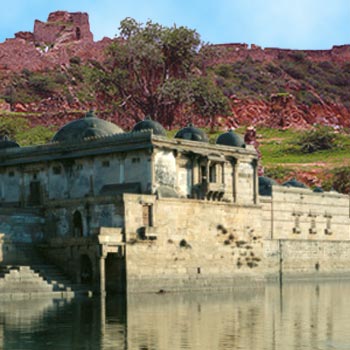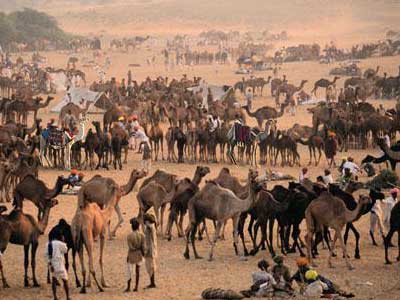Ajmer
Located on the green oasis surrounded by desolate hills, Ajmer has a remarkable past. Founded by Raja Ajay Pal Chauhan in the 7th Century A.D, Ajmer remained under the influence of Chauhan command till 1193 A.D. After Mohammed Ghauri took over Ajmer from Prithviraj Chauhan, it turned out to be a citadel for many dynasties.. Today Ajmer remains a land of composite cultures. You can see a blend of Hinduism and Islam here.
AJMER TRAVEL
Jaipur, which is at 132 km is the nearest airport. There are regular train services from Ajmer to many important destinations. Ahmedabad, Delhi, Mumbai and Jaipur are well connected to Ajmer by express trains. Key destinations around are very well connected by road. Regular bus services operating from Ajmer to these places. There are city buses operated within the city and to Pushkar. There are also auto-rickshaws and taxis, tongas and cycle rickshaws as well.
Ajmer, which has become a popular pilgrimage center for both Hindus and Muslims, is famous for the Dargah Sharif- the tomb of a Sufi saint Khawaja Moinuddin Chisti. Both Hindus and Muslims revere this Dargha equally. Pushkar, a pilgrimage center for the Hindus lies about 11 km from here. Pushkar, which has a beautiful lake, is the abode of Lord Brahma and it has a temple for the deity. Devotees from all over India throng this place in the month of Karthik (Oct-Nov) to take a dip in the holy lake of Pushkar.
Sight seeing in Ajmer
Kwaja Saheb Dargha: One of India's important pilgrimage centers is situated at the foot of a hill and is much revered by people from all faiths. Khawaja Saheb or Khawaja Sharif as it is more popularly known, the marvelous tomb of Khawaja Moinuddin Chisti is considered to be one of the most important shrines, next only to Mecca or Madina by the south Asian Muslims. The great Mughal Emperor Akbar used to visit this Dargah on pilgrimage every year from Agra.
The Nizam of Hyderabad built this mausoleum which has a huge gate. Akbari Masjid built in white marble is on the right side of the courtyard, which is of interest to the visitor with its two enormous cauldrons. Another mosque built by Shahijan is located inside the courtyard.
Surrounded by a silver platform, the center of the second courtyard houses the saint's tomb with a marvelous marble dome. Thousands of pilgrims visit the shrine during the Urs, which is observed in commemoration of the death anniversary of the Saint. The Urs is held every year from 1st to 6th day of the Islamic month of Rajab. A major attraction is a colorful fair that is held during this season.
Shahjhan's Mosque: The most fabulous of all the sanctums inside the sanctuary of the Dargah is this superb building in white marble. It has a 30.5-m long and narrow court that has a low arcade and fragile carvings with trelliswork.
Adhai-din-ka-jhonpra On the outskirts of the city of Ajmer about a few yards from the Khawaja Saheb Dargah, we see this amazing structure which is a blend of Indo-Islamic architecture. The construction of this was completed in two and a half days and hence the name. Mohammed Ghauri converted a building, which was originally a Sanskrit college into a mosque. He added a seven-arched wall facing the pillared wall in a short time. This architectural masterpiece of the arched screen with its ruined minarets and distinct pillars look marvelous.
Fort of Taragarh: The ruins of the Taragarh Fort can be reached by climbing steep steps which takes nearly one and a half hours. Perched on a hill this fort is just beyond the Adai-din-ka-jhonpra. From here you can have a wonderful view of the city. The Mughals used this fort as the site for their military activities, but the British used the place as a sanatorium.
The Museum: The royal residence of Emperor Akbar has been converted into a museum which houses beautiful sculptures and is a rich storage of Rajput and Mughal armor.
Pushkar Lake: Nag Pahar or the snake mountain separates the Pushkar Lake from Ajmer. Located on the edge of the desert, the lake is surrounded by hills on three sides. The Panchkund and Saint Agastya's cave are situated here on this mountain. Scholars believe that Kalidas, the 4th Century Sanskrit poet and playwright wrote his masterpiece Abhigyanam Shakuntalam with this setting of forest heritage as its backdrop.
Legend has it that, the origin of Pushkar dates back to several years. Lord Brahma was in search of a peaceful land to perform a Yagna when a lotus fell down from his hand into this place. Soon a lake appeared on this spot and people dedicated it to the Lord. People revere this place as Brahma's abode and there is a temple dedicated to the deity.
Pushkar Fair: The annual cattle fair during Pushkar fair is very popular. Thousands of pilgrims throng this lake to take a holy dip on the full moon day of Kartik (Oct-Nov. There are cultural events and exciting camel-cart races in addition to trading of horses, camels, cows and bulls. Pilgrims get an opportunity to buy clothes, household items and leather goods during this colorful fair.
Man Mahal: Man Mahal, situated along the banks of the Pushkar Lake is the former palace of Raja Mansingh of Ajmer. It has been converted as Rajasthan Tourist Development Corporation's (RTDC) Sarovar Tourist Bungalow. This is a convenient place for travelers. Adjacent to it is Pushkar Palace or the Krishna Garh house, which is a heritage hotel.
Foy Sagar: An artificial lake created by an engineer under a famine relief project is named after him.
Shopping in Ajmer
Ajmer is a shoppers delight during the annual Urs fair when you can shop for curios, antiques, captivating gold and silver jewelry in contemporary designs, embroidered Jodhpuri Jutis and vibrant tie-and-dye sarees. Delightful creations of traditional folk artisans attract the visitors.
|































